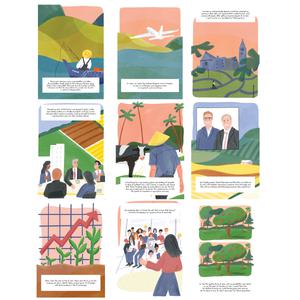Insects are also vanishing rapidly. A recent global review reports that in the current global epoch, the Holocene, the extinction rate is eight times higher for insect species than for mammals, birds, and reptiles. In Germany, for instance, flying insect populations in nature reserves have dropped 75 percent during the last quarter century, while in Puerto Rico, ground insects are down a stunning 98 percent. Overall, the mass of insects on the planet is falling by 2.5 percent annually.
Reports like these are trying to quantify things that aren’t now easily quantifiable. But they can educate the public about how bad things are and about the fundamental role of insects. If there are no beneficial insects, there is no food on this planet.
Why are insect populations falling so precipitously? There are several reasons for their decline, but ultimately humanity—our cities and farms, our technologies and science—is the culprit. Insect populations are unable to adapt to changes to natural habitats caused by deforestation and agriculture, by the use of chemical in farming, and by climate change, especially extremes of weather such as droughts, which are likely to continue increasing in intensity, duration, and frequency.
Among the causes driving insects’ extinction rate, humanity could most easily control its agricultural practices. Modern agriculture relies upon crop monocultures, which attract piercing, sucking, and leaf-feeding insects that damage the crops and can even destroy them. To counter this threat, growers have adopted practices to control pests, including crop rotation, introduction of predatory species, the removal of refuge species from fields or surrounding areas, and the use of chemicals.
Around 4,500 years ago, the Sumerians discovered that sulfur compounds could be used to control mites. About 2,000 years ago, pyrethrum extracted from Chrysanthemum cinerariaefolium was found to protect stored grain. In recent decades, agricultural insecticides have been highly effective in controlling pests. They were an essential component of the Green Revolution, which led to huge increases in food production. The revolution came at a cost, however: the loss of beneficial insects and nontarget insects such as butterflies, and impacts upon species, such as birds, that feed on insects.
Each new generation of insecticides offers faster rates of decomposition and more specific modes of action—and so we think we have solved the problem. But insects are delicate creatures, and good insects continue to die at alarming rates. No one predicted, for instance, that exposure to low doses of neonicotinoids would result in bees losing their orientation when returning to their hives.
If our civilization is to feed the nearly 10 billion people projected to be alive in 2050, we will need to improve the health and performance of agriculturally vital insects, while eliminating pests in a natural and sustainable manner. We will need to reimagine contemporary agricultural practices—in particular, greatly reducing pesticide usage and substituting more sustainable, ecologically based practices. The changes are urgently needed to slow or reverse current trends, allow the recovery of declining insect populations, and safeguard the vital ecosystem services they provide.







